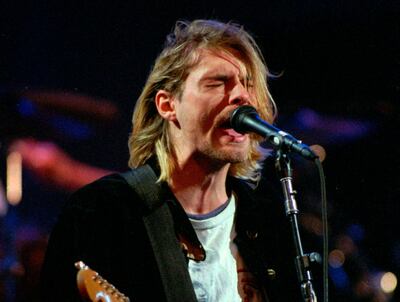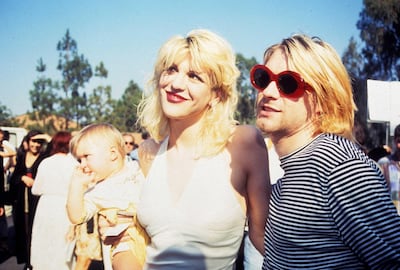Kurt Cobain’s death fulfils frustratingly few of the neat what / where / when principles journalists live by. It’s known that the rock star’s lifeless body was discovered with a shotgun leaning on the chest on April 8, 1994 – but no one can be certain when, or perhaps who, pulled the trigger.
Experts date Cobain's death to three days earlier, but while denial-racked conspiracy theorists continue to doubt the "who?", 25 years after that date, maybe the real mystery is "why?".
Despite the presence of an eerie Neil Young-quoting suicide note, a quarter-century's perspective hasn't helped the world explain why the lead singer of epoch-changing American rock band Nirvana – then one of the most famous people on the planet – would choose to end his life. And as the recent suicides of Cobain's grunge contemporary Chris Cornell, Linkin Park's Chester Bennington, EDM DJ and musician Avicii and Prodigy frontman Keith Flint illustrate, there has been little progress in addressing addiction and mental health in the music world.
Cobain's suicide will forever overshadow his work, muddy his legacy and shape any audience's appreciation of his achievements. It is sadly never possible to separate the artist from the art, but in the case of Cobain, the myth is so overwhelming, the imagery so pervasive – the gloomy music so intertwined with the tortured soul – that any claim of objective perspective feels incredibly fraught.
A lasting legacy
The latest tributes come from former manager Danny Goldberg, whose new memoir Serving the Servant: Remembering Kurt Cobain was rush-released this week to mark the anniversary. It joins a growing stack of literature on Nirvana, and especially Cobain, surely unrivalled in volume by any major artist working since the generation of 1960s pop pioneers to which Bob Dylan and The Beatles belong.
Hyperbole may be a rock critic's best friend, and posterity a dying record industry's favourite tactic, but even the most level-headed historian would struggle to downplay Cobain's cultural impact. Before Nirvana, "alternative music" was just that – edgy, independent releases sold in specialist shops and mail order cliques – an "alternative" to the mainstream. Cobain's most lasting influence will always be taking raw, dirty, angsty, DIY music to the masses – and MTV. Or making shrill cathartic pleas and intimate confessions an alternative to cliched rock bravado.
The grunge wave Cobain fronted kicked out 1980s pop and rock, and set the glum tone for modern guitar music forevermore, from Korn, Linkin Park and Nickelback to early Radiohead and beyond. What then seemed like a passing trend was arguably rock's last hurrah – a milieu today held up with more misty-eyed affection than any movement in guitar music since. In truth, grunge was a nebulous conceit, coined by journalists lazily clumping together scruffily dressed rockers of different musical allegiances – Seattle also-rans Pearl Jam, Cornell's Soundgarden and Alice in Chains owed more to the big riffs of commercial 1970s rock and heavy metal.
Heralding a new era
Nirvana were the more truly alternative band, instead taking equal cues from the scratchy DIY aesthetic of 1980s punk rock, extreme metal and dirgy, overlooked underground acts like Melvins, The Smithereens, The Vaselines and Meat Puppets – who Cobain invited onstage, singing three of their songs for a swansong MTV Unplugged in New York. Taped in November 1993 and released as an album a year later, after Cobain's death, this eclectic live performance would serve as a fitting eulogy and revelatory last act.
In Cobain's lifetime, Nirvana were known for noise. For messy feedback, impenetrable rhymes, thrashed power chords and snarled, senseless yelps. For the loud-quiet-loud headbanging Smells Like Teen Spirit and head-aching Heart-Shaped Box. For the monumental overdrive of 1991's 30-million selling breakout Nevermind – courtesy of producer Butch Vig – and the bare, bone-breaking "Steve Albini sound" of follow-up In Utero, two years later.
"Like a funeral," was supposedly the brief Cobain gave producer Alex Coletti for adorning the MTV stage with white lilies, black candles and a lonesome chandelier for the intimate, all-acoustic live show.
It was the wake for a uniformly downbeat, tortured set, recasting Cobain's weariest, most fragile laments astride six eclectic covers which would redefine his legacy – including David Bowie's dreamy The Man Who Sold the World and the howled closer Where Did You Sleep Last Night?, by 1930s blues singer Lead Belly, still a reliable goose-bump raiser despite overexposure. The fact Cobain first attempted, then succeeded, in killing himself a few months later makes these overwrought performances all the more powerful, arresting and disturbing. But those lilies aren't the only troubling element of theatre in Cobain's flirtations with mortality.
He famously swore he didn't have a gun – repeatedly – in the poppy chorus to Nirvana's second-biggest hit Come As You Are, before posing for photo shoots with a pistol aimed at his chin. In the same month as taping Unplugged, the throwaway I Hate Myself and Want to Die emerged – originally mooted as a title track for In Utero, but rejected because Cobain worried many might not find the "joke" funny. It wasn't in the end.
Unplugged was just the first precious drops of a tsunami of posthumous product to emerge in the past 25 years, with countless hours of scratchy out-takes and unlistenable boombox rehearsals now incongruously available to the public, the coffers most thoroughly raided for 2004's sprawling three-disc With the Lights Out box set.
More unnerving was the tortured screams and tuneless home-taped yodels of 2015's Montage of Heck, a sort-of soundtrack to that year's documentary of the same name – a controversial portrait that displays a gruesome preoccupation with Cobain's mental health and drug abuse, with scant examination of the music.
His inner torment
And this is the troubling tragedy of Cobain's legacy. It helps neither depressed teens nor supernatural crackpots that Cobain was 27 at the time of his suicide – the same age Jimi Hendrix, Janis Joplin, The Doors' Jim Morrison and The Rolling Stones' Brian Jones, who all died of misadventure. However, the idea of a cursed geniuses' "27 Club" only came 23 years later, when Cobain's distraught mother sobbed to reporters, "I told him not to join that stupid club." Hedonist chic gained another victim when Amy Winehouse died in 2011, aged a sorry 27.
It's not easy for anyone to serve as the spokesperson for a generation, but quick-witted Cobain seemingly made maladjusted discontent and media antagonism appear an art-form. His widow Courtney Love implies he "chose" a life of drug abuse, and Cobain's strung out visage is the epitome of the oxymoronic phrase "elegantly wasted". Marc Jacobs's high-end grunge clothing range may have little to do with Cobain's thrift-store rags that inspired them – but like a Che Guevara or Bob Marley T-shirt, a Cobain image today represents a statement more cultural than musical. And it's not One Love or socialist revolt that Cobain stood for.
"Teenage angst has paid off well, now I'm bored and old," Cobain sang on In Utero's opener Serve the Servants. He always had a shrewd awareness of his legacy and repute, as the theatre of Unplugged and the scrawl of his suicide note show – complete with that priceless Neil Young quote, "It's better to burn out than to fade away."
Cobain surely could have predicted the pained vigils and lucrative box sets to come, in the years after he pulled the trigger of that gun he promised us he didn’t own. Cobain knew he was a public figure, a role model adored by millions of teens – he just didn’t seem to care. And it wasn’t enough to save him.




